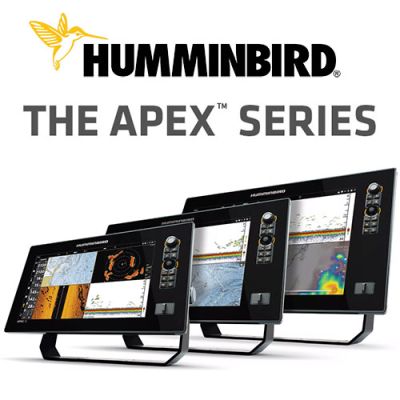Today's Best Fishing Times
Get the best fishing times for Trout Lake with Lake-Link's Fishing Forecast. SEE MORE
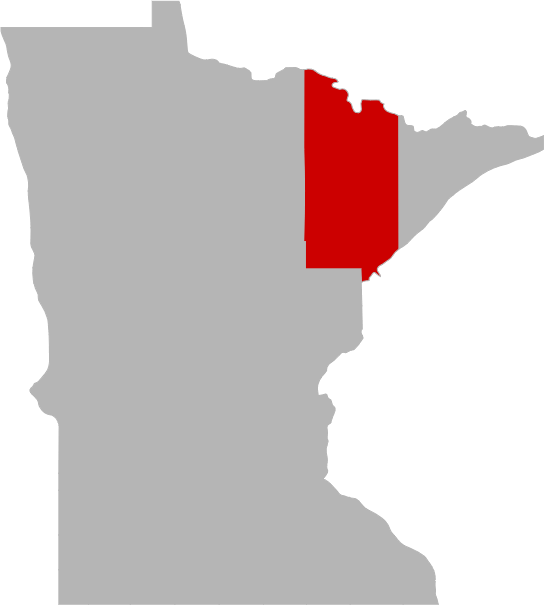
The lake has a maximum depth of 98 feet. It is surrounded by forests and rolling hills, which provide a picturesque backdrop for water-based activities such as boating, fishing, and swimming. The lake is home to a variety of fish species, including lake trout, walleye, northern pike, bass, and panfish, which are popular targets for anglers.
Trout Lake is also an important ecological resource, providing habitat for a variety of plant and animal species. The lake is part of the Superior National Forest and is managed by the Minnesota Department of Natural Resources to protect and conserve the area's natural resources.
In addition to its natural beauty and recreational opportunities, Trout Lake is surrounded by several parks, campgrounds, and resorts, making it a popular vacation destination. The area also offers hiking and biking trails, hunting opportunities, and other outdoor activities for visitors to enjoy.

Explore Lake Vermilion
Share your catch!
We want to see what you've caught on Trout Lake.Frequently Asked Questions About Trout Lake, MN
- How big is Trout Lake?
- How deep is Trout Lake?
- What kind of fish can you catch in Trout Lake?
- Are there places to stay in the Trout Lake area?
- Are there places to eat and drink near Trout Lake?
- What is the average air temp for Trout Lake?
- Are there any state parks near Trout Lake?
How big is Trout Lake?
How deep is Trout Lake?
What kind of fish can you catch in Trout Lake?
Other fish species in the lake include Cisco (Tullibee), Hybrid Sunfish and White Sucker.
Are there places to stay in the Trout Lake area?
More Lodging Options
Trout Lake area businesses:

Are there places to eat and drink near Trout Lake?
Explore the Trout Lake area in a RV
Are you looking for an adventurous vacation option that won't break the bank? Look no further than renting an RV! Contrary to popular belief, the process is much simpler than you might imagine. With just a few easy steps, you'll soon be experiencing the ultimate freedom and convenience of exploring the open road in your very own recreational vehicle. And the best part? RV travel can save you up to 60% compared to other types of vacations! With the money you'll save, you'll be able to travel even more and create unforgettable memories along the way. So why wait? Start planning your next adventure today with an RV rental. Learn more about renting a RV.
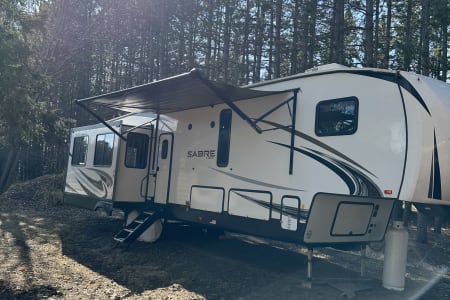
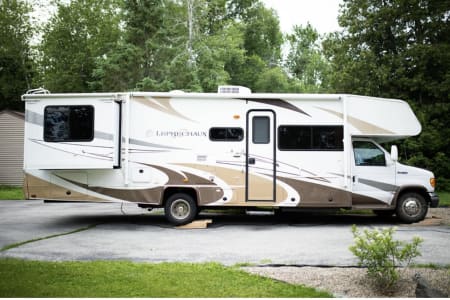
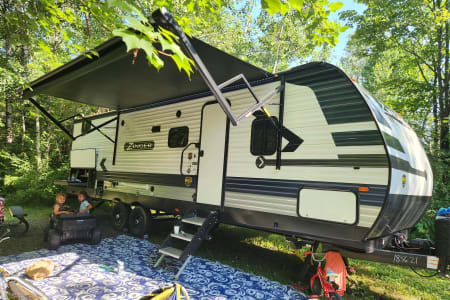
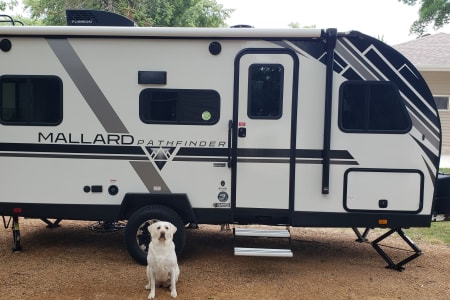
Adventure Awaits in the 2021 Heartland Mallard Pathfinder P16SRD
Hermantown, MN
History & Status of the Fishery
Trout Lake is in Ecological Lake Class 2, which consists of 15 lakes in northeast Minnesota that are very large, deep, have irregular shoreline shapes, and have clear and soft (unmineralized) water. Trout Lake is smaller than most of the lakes in this lake class.
Trout Lake was thermally stratified on 7/28/2008 with surface temperatures of 70 F and bottom temperatures of 47 F. Adequate oxygen for trout (more than 5 ppm) was retained to a depth of 82 ft where the temperature was 47 F, and adequate oxygen for warmer water fish species (more than 2 ppm) was retained to the bottom, where there was 3.6 ppm oxygen. Trout Lake ranks as mestrophic-to-oligotrophic according to Carlson's Trophic State Index.
The major inlet to Trout Lake is from Pine Lake and has rapids at the inlet and a beaver dam upstream, both of which limit fish movement. The inlet from Little Trout Lake is navigable at high water and shallow at low water. Other inlets are seasonal drainages from local bogs. The outlet, to Lake Vermilion, has a steep rocky rapids which limits fish movement. There is a known walleye spawning run in the narrows to Little Trout Lake, which is heavily fished by anglers each spring.
Lake bottom substrates along the shoreline of Trout Lake are mostly boulder, rubble, gravel, and ledgerock. Aquatic plants are sparse and grow to a depth of 12 ft. Most plants are in shallow protected bays; the most common plants are sweetgale and sedges along the shore fringe, and water lobelia, water horehound, and quillwort.
Trout Lake is in the Boundary Waters Canoe Area Wilderness, administered by the La Croix Ranger District of the U.S. Forest Service. There are 44 campsites on the lake and camping is limited to these campsites. A BWCAW permit is required to visit Trout Lake; quotas are established, fees are assessed for overnight stays, and there is a fee to reserve camping or motor use permits. Day-use non-motorized permits have no quotas or fees. Unreserved day motor use permits have no fee, but are subject to quotas. Outboard use is limited to 25 horsepower maximum and snowmobiles are prohibited. Most access to Trout Lake is by the truck portage from Lake Vermilion, where a concessionaire will pull boats to Trout Lake using an ATV and boat trailer. In 2008, the round-trip fee was about $30, depending on the size of the load. A canoe portage from Lake Vermilion along Trout Creek (36 rods) is also heavily used.
Fish sampling in the 2008 fish population assessment was done with shallow gillnets set in water warmer than 55 F in depths of 8 ft to 23 ft, and deep gillnets set in water colder than 55 F in depths of 42 ft to 87 ft. Previously, three fisheries lake surveys and eight fish population assessments dating back to 1958 consisted of 7-20 deep gillnet sets. Shallow gillnets (4-8 sets) were used during six of these investigations, and shoreline seines were used only during the three surveys. Trapnets were used for the first time in 2002. Quartile statistics for comparing gillnet catches in Trout Lake to other lakes in this lake class have not been calculated for stratified shallow and deep gillnet sets, so are not provided in this report.
SHALLOW WATER FISH POPULATIONS:
Shallow water fish populations in 2008 were dominated by walleye and rock bass. Bluegill sunfish were abundant in the trapnets in 2002, but they are not sampled well with gillnets and so are probably more abundant than indicated in the 2008 investigation where no trapnets were used. Smallmouth bass numbers appear to be increasing, plus bass are "net-shy" and difficult to catch in standard sampling nets, so their numbers were probably underrepresented in the net catches. Yellow perch numbers were low in the shallow gillnets in 2008, but small yellow perch were the most common food item found in walleye stomachs, so perch numbers may be higher than indicated by the gillnet catch. The total catch of fish (all species combined) in the shallow gillnets in 2008 of 38.8 fish/net (30.9 lb/net) was similar to the median catch of 31.0 fish/net (27.4 lb/net) in all investigations on this lake.
Walleye numbers in 2008 (18.5/shallow gillnet) were high when compared to most area lakes, but were similar to the median catch of 15.0/shallow gillnet in all investigations on this lake. Walleye sizes in 2008 averaged 13.8" (1.1 lb), which was similar to the long-term average size in this lake of 13.1". The largest walleye was 26.3". The strongest year-class was from 2005 and comprised 47 percent of all walleye caught in 2008. Growth of walleye age 1-5 was somewhat slower than normal (in the second quartile) by area standards, while growth of walleye age 6 and older appeared to be faster than normal.
Rock bass numbers in 2008 (14.5/shallow gillnet) were higher than the median catch of 9.7/shallow gillnet in all investigations on this lake. Rock bass sizes averaged 6.1"; the largest rock bass was 8.1"
Smallmouth bass were not reported as being present in the initial lake survey in 1958. Their numbers have gradually increased to their abundance in 2008 of 3.0/shallow gillnet. In 2002 they were also present in the trapnets and shoreline seines, and were visually observed in the shallows by the survey crew. Smallmouth bass sizes in 2008 averaged 10.4"; the largest was 14.6". Smallmouth growth was normal by area standards.
A few of the shallow water game fish examined in 2008 were infected with neascus (black spot). Most of the smallmouth bass also were infected with bass tapeworm larvae in their viscera.
DEEP WATER FISH POPULATIONS
Deep water fish sampling was done in 2008 to evaluate the survival and growth of lake trout yearlings which have been stocked biennially (in odd years) in Trout Lake at the rate of 38,000 per stocking (5.0 per acre) since 1995. Gillis Lake strain yearlings were stocked from 1995 through 2003 and Mountain Lake strain yearlings were stocked in 2005 and 2007. All of these stocked trout had clipped fins (adipose, left ventral, right ventral, or a combination of the adipose and one of the ventral fins, depending on the year) so they could be identified at recapture. Also of interest were young unclipped trout that would indicate natural reproduction of the remnant lake trout population in the lake, and populations of cisco and burbot.
Lake trout numbers in 2008 (1.1/deep gillnet) were higher than the median lake trout catch of 0.7/deep gillnet in all investigations on this lake, but were lower than the median catch of 2.2/deep gillnet in recent investigations on 33 lake trout lakes in the Tower Fisheries Management Area. Many of the stomachs of lake trout captured in 2008 contained cisco, although sculpins and sticklebacks were also found.
Eighteen lake trout were captured in 2008. Seven of these trout had clipped fins (all were left pelvic fin-clips), indicating they had been stocked. Comparison with the stocking record and previous catches of fin-clipped trout indicates that three of these trout, averaging 19.1", were likely age four from the 2005 stocking of Mountain Lake strain yearlings. The remaining four clipped trout, averaging 24.5", were likely age six from the 2003 stocking of Gillis Lake strain yearlings. No otoliths were taken from fin clipped trout in 2008.
Ageing of the ten unclipped trout from which otolith samples were taken proved to be problematic, as growth of these fish appeared to be much slower than growth of the clipped fish. For example, two unclipped trout, averaging 16.5", were aged at 6 years, while four unclipped trout averaging 19.4" were aged at 8-10 years.
While stocked yearling trout should have somewhat better growth because their first year was in a hatchery instead of the wild, the observed discrepancy this year seems too large. It should be noted that the fin-clipping regime was recently changed to accommodate a comparison of Gillis Lake and Mountain Lake strains, and as a result two consecutive stockings of left pelvic clips were done (in 2003 - Gillis Lake strain, and 2005 - Mountain Lake strain). In the future, identical clips will separate stocked lake trout by four years instead of the six years originally planned. Also, the person that had read our lake trout otoliths retired and a new person began reading otoliths this year by cracking and burning one otolith of each pair and sending the matching otolith to Paul Hauck, who has much experience and training in reading lake trout otoliths. These two readings for each fish matched remarkably well, although Paul said they were very dense and difficult to read. In the future, otoliths should be taken both from unclipped trout and from fin-clipped trout to try to resolve the apparent discrepancy in their ages.
Burbot numbers in 2008 (0.2/deep gillnet) were lower than the median burbot catch of 0.8/deep gillnet in all investigations on this lake, and continues a trend of low burbot numbers following very high burbot catches in the 1990's. Burbot numbers in Trout Lake have cycled between low numbers (an average of 0.6/deep gillnet in four investigations from 1969 through 1987 and an average of 0.2/deep gillnet in four investigations from 2002 through 2008) and high numbers (5.0/deep gillnet in 1958 and an average of 5.6/deep gillnet in three investigations from 1992 through 1998). Burbot sizes in 2008 averaged 17.7", which was similar to the average size of 18.9" in all investigations on this lake. The largest burbot captured in 2008 was 18.7".
Cisco numbers in 2008 (70.7/deep gillnet) were higher than the median catch of 49.9/deep gillnet in all investigations on this lake. Cisco sizes in 2008 averaged 9.0", which is similar to the average length of 8.9" in all investigations on this lake. The largest cisco captured in 2008 was 17.7". Cisco were not examined for parasites in 2008, but previous investigations have shown that many are infected with bladder roundworm and triaenophorus.
All of the parasites found on game fish in 2008 are native to the area and are common. They cannot infect humans, are often removed by filleting, and are killed at temperatures used to cook fish.
Angler reports in the last few years indicate that the lake trout population, which had been low and consisted mostly of a few large fish, is recovering. More small trout, both naturally produced and fin-clipped (stocked) are being caught. Fewer burbot have been reported by anglers in recent years.
What is the average air temp for Trout Lake?
Are there any state parks near Trout Lake?
For more Minnesota State Park information see our State Park Guide.
More Nearby Lakes To Explore
There's more lake's to explore around Trout Lake...| DISTANCE | ACRES | MAX DEPTH | |
| Merritt Lake | 1.9 mi | 198 | 8 ft |
| Little Trout Lake | 2.4 mi | 528 | 37 ft |
| Oriniack Lake | 2.5 mi | 744 | 17 ft |
| Dugout Lake | 3.4 mi | 57 | 9 ft |
| Pine Lake | 4.0 mi | 830 | 18 ft |
| Gowan Lake | 4.3 mi | 134 | 13 ft |
| Chad Lake | 4.4 mi | 265 | 18 ft |
| Wolf Lake | 5.7 mi | 179 | 10 ft |
| Buck Lake | 6.0 mi | 208 | 19 ft |
| Western Lake | 6.6 mi | 131 | 12 ft |







